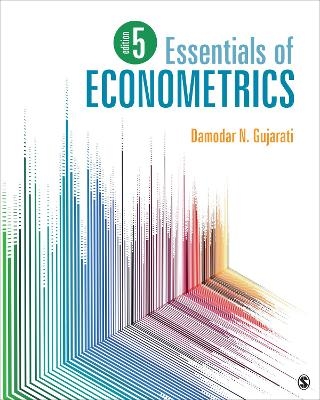
Essentials of Econometrics
SAGE Publications Inc (Verlag)
978-1-0718-5039-8 (ISBN)
This updated Fifth Edition of Damodar N. Gujarati′s classic text provides a user-friendly overview of the basics of econometric theory from ordinal logistic regression to time series. Acclaimed for its accessibility, brevity, and logical organization, the book helps beginning students understand econometric techniques through extensive examples (many new to this edition), careful explanations, and a wide array of chapter-ending questions and problems. Major developments in the field are covered in an intuitive and informative way without resorting to matrix algebra, calculus, or statistics beyond the introductory level.
A companion website for the book includes resources for both instructors and students. Further details are on the Resources tab above.
Damodar Gujarati (M.B.A. and Ph.D., both from University of Chicago) is Professor Emeritus of economics at the United States Military Academy at West Point. Prior to that, he taught for 25 years at the Baruch College of the City University of New York (CUNY) and at the Graduate Center of CUNY. He is the author of Government and Business, (McGraw Hill, 1984), the bestselling textbook Basic Econometrics (5th edition, 2009, with co-author Dawn Porter), as well as Essentials of Econometrics (4th edition, 2009, also with co-author Dawn Porter), both published by McGraw-Hill, and also Econometrics by Example (2nd edition, 2014, Palgrave-Macmillan). His experience spans business, consulting, and academia.
Acknowledgments
Preface
About the Author
Chapter 1. The Nature and Scope of Econometrics
1.1 What Is Econometrics?
1.2 Why Study Econometrics?
1.3 The Methodology Of Econometrics
1.4 The Road Ahead
Key Terms and Concepts
Questions
Problems
Appendix 1A: Economic Data on the World Wide Web
PART I. THE LINEAR REGRESSION MODEL
Chapter 2. Basic Ideas of Linear Regression: The Two-Variable Model
2.1 The Meaning of Regression
2.2 The Population Regression Function (PRF): A Hypothetical Example
2.3 Statistical or Stochastic Specification of The Population Regression Function
2.4 The Nature of the Stochastic Error Term
2.5 The Sample Regression Function (SRF)
2.6 The Special Meaning of the Term Linear Regression
2.7 Two-Variable Versus Multiple Linear Regression
2.8 Estimation of Parameters: The Method of Ordinary Least Squares
2.9 Putting It All Together
2.10 Some Illustrative Examples
2.11 Summary
Key Terms and Concepts
Questions
Problems
Optional Questions
Appendix 2A: Derivation of Least Squares Estimators
Chapter 3. The Two-Variable Model: Hypothesis Testing
3.1 The Classical Linear Regression Model
3.2 Variances and Standard Errors of Ordinary Least Squares Estimators
3.3 Why OLS? Properties of OLS Estimators
3.4 The Sampling, or Probability, Distributions of OLS Estimators
3.5 Hypothesis Testing
3.6 Hypothesis Testing: Some Practical Aspects
3.7 How Good Is The Fitted Regression Line: The Coefficient of Determination, r2
3.8 Reporting the Results of Regression Analysis
3.9 Illustrative Examples
3.10 Comments on the Illustrative Examples
3.11 Forecasting
3.12 Normality Tests
3.13 Summary
Key Terms and Concepts
Questions
Problems
Chapter 4. Multiple Regression: Estimation and Hypothesis Testing
4.1 The Three-Variable Linear Regression Model
4.2 Assumptions of the Multiple Linear Regression Model
4.3 Estimation of the Parameters of Multiple Regression
4.4 Goodness of Fit of Estimated Multiple Regression: Multiple Coefficient of Determination, R2
4.5 Antique Clock Auction Prices Revisited
4.6 Hypothesis Testing In A Multiple Regression: General Comments
4.7 Testing Hypotheses About Individual Partial Regression Coefficients
4.8 Testing the Joint Hypothesis That B2 = B3 = 0 Or R2 = 0
4.9 Two-Variable Regression In the Context of Multiple Regression: Introduction to Specification Bias
4.10 Comparing Two R2 Values: The Adjusted R2
4.11 When to Add an Additional Explanatory Variable to a Model
4.12 Restricted Least Squares
4.13 Illustrative Examples
4.14 Summary
Key Terms and Concepts
Questions
Problems
Appendix 4A.1: Derivations of OLS Estimators
Appendix 4A.2: Derivation of Equation (4.31)
Appendix 4A.3: Derivation of Equation (4.49)
Chapter 5. Functional Forms of Regression Models
5.1 How to Measure Elasticity: The Log-Linear Model
5.2 Multiple Log-Linear Regression Models
5.3 How to Measure the Growth Rate: The Semilog Model
5.4 The Lin-Log Model: When the Explanatory Variable Is Logarithmic
5.5 Reciprocal Models
5.6 Polynomial Regression Models
5.7 Regression Through the Origin: The Zero Intercept Model
5.8 A Note on Scaling and Units of Measurement
5.9 Regression on Standardized Variables
5.10 Summary of Functional Forms
5.11 SUMMARY
Key Terms and Concepts
Questions
Problems
Appendix 5A: Logarithms
Chapter 6. Qualitative or Dummy Variable Regression Models
6.1 The Nature of Dummy Variables
6.2 ANCOVA Models: Regression on One Quantitative Variable and One Qualitative Variable With Two Categories
6.3 Regression on One Quantitative Variable and One Qualitative Variable With More Than Two Classes or Categories
6.4 Regression on One Quantiative Explanatory Variable and More Than One Qualitative Variable
6.5 Comparing Two Regessions
6.6 The Use of Dummy Variables In Seasonal Analysis
6.7 What Happens if the Dependent Variable Is Also a Dummy Variable? The Linear Probability Model (LPM)
6.8 The Logit Model
6.9 Summary
Key Terms and Concepts
Questions
Problems
PART II. REGRESSION ANALYSIS IN PRACTICE
Chapter 7. Model Selection: Criteria and Tests
7.1 The Attributes of a Good Model
7.2 Types of Specification Errors
7.3 Omisson of Relevant Variable Bias: “Underfitting” a Model
7.4 Inclusion of Irrelevant Variables: “Overfitting” a Model
7.5 Incorrect Functional Form
7.6 Errors of Measurement
7.7 Detecting Specification Errors: Tests of Specification Errors
7.8 Outliers, Leverage, and Influence Data
7.9 Probabity Distribution of the Error Term
7.10 Model Evaluation Criteria
7.11 Nonnormal Distribution of the Error Term
7.12 Fixed Versus Random (or Stochastic) Explanatory Variables
7.13 Summary
Key Terms and Concepts
Questions
Problems
Chapter 8. Multicollinearity: What Happens if Explanatory Variables Are Correlated?
8.1 The Nature of Multicollinearity: The Case of Perfect Multicollinearity
8.2 The Case of Near, or Imperfect, Multicollinearity
8.3 Theoretical Consequences of Multicollinearity
8.4 Practical Consequences of Multicollinearity
8.5 Detection of Multicollinearity
8.6 Is Multicollinearity Necessarily Bad?
8.7 An Extended Example: The Demand for Chickens In The United States, 1960 To 1982
8.8 What to Do With Multicollinearity: Remedial Measures
8.9 Summary
Key Terms and Concepts
Questions
Problems
Chapter 9. Heteroscedasticity: What Happens if the Error Variance Is Nonconstant?
9.1 The Nature of Heteroscedasticity
9.2 Consequences of Heteroscedasticity
9.3 Detection of Heteroscedasticity: How Do We Know When There Is a Heteroscedasticity Problem?
9.4 What to Do if Heteroscedasticity Is Observed: Remedial Measures
9.5 White’s Heteroscedasticity-Corrected Standard Errors and t Statistics
9.6 Some Concrete Examples of Heteroscedasticity
9.7 Summary
Key Terms and Concepts
Questions
Problems
Chapter 10. Autocorrelation: What Happens If Error Terms Are Correlated?
10.1 The Nature of Autocorrelation
10.2 Consequences of Autocorrelation
10.3 Detecting Autocorrelation
10.4 Remedial Measures
10.5 How to Estimate p
10.6 A Large Sample Method of Correcting OLS Standard Errors: The Newey–West (NW) Method
10.7 A General Test of Autocorrelation: The Breusch–Godfrey (BG) Test
10.8 Summary
Key Terms and Concepts
Questions
Problems
PART III. ADVANCED TOPICS IN ECONOMETRICS
Chapter 11. Elements of Time-Series Econometrics
11.1 The Phenomenon of Spurious Regression: Nonstationary Time Series
11.2 Tests of Stationarity
11.3 Cointegrated Time Series
11.4 The Random Walk Model
11.5 Causality In Economics: The Granger Causality Test
11.6 Summary
Key Terms and Concepts
Problems
Chapter 12. Panel Data Regression Models
12.1 The Importance of Panel Data
12.2 An Illustrative Example: Charitable Giving
12.3 Pooled OLS Regression of the Charity Function
12.4 The Fixed-Effects Least Squares Dummy Variable (LSDV) Model
12.5 Limitations of the Fixed-Effects LSDV Model
12.6 The Fixed-Effects Within-Group (WG) Estimator
12.7 The Random-Effects Model (REM) or Error Components Model (ECM)
12.8 Properties of Various Estimators
12.9 Panel Data Regressions: Some Concluding Comments
12.10 Summary and Conclusions
Key Terms and Concepts
Problems
INTRODUCTION TO APPENDIXES A, B, C, AND D: BASICS OF PROBABILITY AND STATISTICS
Appendix A: Review of Statistics: Probability and Probability Distributions
A.1 Some Notation
A.2 Experiment, Sample Space, Sample Point, and Events
A.3 Random Variables
A.4 Probability
A.5 Random Variables and Their Probability Distributions
A.6 Multivariate Probability Density Functions
A.7 Summary and Conclusions
Key Terms and Concepts
References
Questions
Problems
Appendix B: Characteristics of Probability Distributions
B.1 Expected Value: A Measure of Central Tendency
B.2 Variance: A Measure of Dispersion
B.3 Covariance
B.4 Correlation Coefficient
B.5 Conditional Expectation
B.6 Skewness and Kurtosis
B.7 From Population to the Sample
B.8 Summary
Key Terms and Concepts
Questions
Problems
Optional Exercises
Appendix C: Some Important Probability Distributions
C.1 The Normal Distribution
C.2 The t Distribution
C.3 The Chi-Square (?2) Probability Distribution
C.4 The F Distribution
C.5 Summary
Key Terms and Concepts
Questions
Problems
Appendix D: Statistical Inference: Estimation and Hypothesis Testing
D.1 The Meaning of Statistical Inference
D.2 Estimation and Hypothesis Testing: Twin Branches of Statistical Inference
D.3 Estimation of Parameters
D.4 Properties of Point Estimators
D.5 Statistical Inference: Hypothesis Testing
D.6 Summary
Key Terms and Concepts
Questions
Problems
Appendix E: Statistical Tables
Index
| Erscheinungsdatum | 14.09.2021 |
|---|---|
| Verlagsort | Thousand Oaks |
| Sprache | englisch |
| Maße | 203 x 254 mm |
| Gewicht | 1340 g |
| Themenwelt | Sozialwissenschaften ► Politik / Verwaltung ► Politische Theorie |
| Wirtschaft ► Volkswirtschaftslehre ► Ökonometrie | |
| ISBN-10 | 1-0718-5039-3 / 1071850393 |
| ISBN-13 | 978-1-0718-5039-8 / 9781071850398 |
| Zustand | Neuware |
| Informationen gemäß Produktsicherheitsverordnung (GPSR) | |
| Haben Sie eine Frage zum Produkt? |
aus dem Bereich


